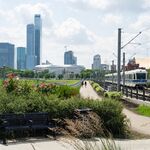Fastest - maybe? How long would it take to significantly improve the QEII between Calgary and Edmonton?
Cheapest - not really. The only realistic way of doing that is what? Adding a lane to QEII and repaving the existing road (which is in subpar condition currently, for the most part). It would cost billions, and the long-term maintenance costs would add even more to this tally. In the long term, rail is ALWAYS cheaper than roads.
And also, unlike in California, the ROW already exists here, the terrain is A LOT simpler, to mention two monumental differences.
Easiest - Yeah, I'll give you that one... But is easiest always best?
Bus services are not nearly as reliable, safe and fast as trains, especially in the winter, and the possibility of connecting YEG and YYC adds extra benefits to the whole endeavour. Real services are also much more scalable, and should the need to increase capacity, it's just much easier to add more trains (or cars to the existing ones, if capacity is the only concern) than add extra busses.
I would LOVE to understand the fetish for car infrastructure when rail is a much more efficient way to move both people and good in larger quantities, especially across long distances.




